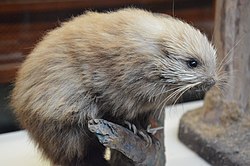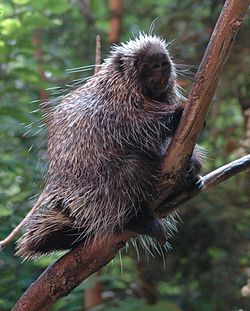| Common name | Scientific name and subspecies | Range | Size and ecology | IUCN status and estimated population |
|---|
| Andean porcupine  | C. quichua
Thomas, 1899 | Panama and northeastern South America | Size: 33–44 cm (13–17 in) long, plus 26–41 cm (10–16 in) tail [6]
Habitat: Forest [7]
Diet: Leaves, stems, fruit, flowers, and roots [8] | DD
Unknown  [7] [7]
|
|---|
| Bahia porcupine  | C. insidiosus
(Olfers, 1818) | Eastern Brazil | Size: 29–35 cm (11–14 in) long, plus 18–22 cm (7–9 in) tail [3]
Habitat: Forest [9]
Diet: Leaves, stems, fruit, flowers, and roots [8] | LC
Unknown  [9] [9]
|
|---|
| Baturite porcupine  | C. baturitensis
Feijó & Langguth, 2013 | Northeastern Brazil | Size: 46–55 cm (18–22 in) long, plus 32–47 cm (13–19 in) tail [3]
Habitat: Forest [10]
Diet: Leaves, stems, fruit, flowers, and roots [8] | DD
Unknown  [10] [10]
|
|---|
| Bicolored-spined porcupine  | C. bicolor
(Tschudi, 1844)
- C. b. bicolor
- C. b. quichua
- C. b. richardsoni
- C. b. simonsi
| Western and northwestern South America
 | Size: 38–50 cm (15–20 in) long, plus 33–54 cm (13–21 in) tail [6]
Habitat: Forest [11]
Diet: Leaves, stems, fruit, flowers, and roots [8] | LC
Unknown  [11] [11]
|
|---|
| Black dwarf porcupine  | C. nycthemera
(Olfers, 1818) | Northern Brazil
 | Size: 29–38 cm (11–15 in) long, plus 28–37 cm (11–15 in) tail [6]
Habitat: Forest [12]
Diet: Leaves, stems, fruit, flowers, and roots [8] | DD
Unknown  [12] [12]
|
|---|
| Black-tailed hairy dwarf porcupine  | C. melanurus
(Wagner, 1842) | Northern South America | Size: 28–38 cm (11–15 in) long, plus 22–36 cm (9–14 in) tail [6]
Habitat: Forest [13]
Diet: Leaves, stems, fruit, flowers, and roots [8] | LC
Unknown  [13] [13]
|
|---|
| Brazilian porcupine  | C. prehensilis
(Linnaeus, 1758) | South America
 | Size: 29–48 cm (11–19 in) long, plus 31–43 cm (12–17 in) tail [3]
Habitat: Forest [14]
Diet: Leaves, stems, fruit, flowers, and roots [8] | LC
Unknown  [14] [14]
|
|---|
| Brown hairy dwarf porcupine  | C. vestitus
Thomas, 1899 | Central Colombia | Size: 29–37 cm (11–15 in) long, plus 17–19 cm (7–7 in) tail [6]
Habitat: Forest [15]
Diet: Leaves, stems, fruit, flowers, and roots [8] | DD
Unknown  [15] [15]
|
|---|
| Dwarf porcupine  | C. speratus
Pontes, Gadelha, Melo, de Sá, Loss, Caldara Jr., Costa, & Leite, 2013 | Eastern Brazil | Size: 33–44 cm (13–17 in) long, plus 29–32 cm (11–13 in) tail [6]
Habitat: Forest [16]
Diet: Leaves, stems, fruit, flowers, and roots [8] | VU
Unknown  [16] [16]
|
|---|
| Frosted hairy dwarf porcupine
| C. pruinosus
Thomas, 1905 | Colombia and Venezuela | Size: 32–38 cm (13–15 in) long, plus about 19 cm (7 in) tail [6]
Habitat: Forest [17]
Diet: Leaves, stems, fruit, flowers, and roots [8] | LC
Unknown  [17] [17]
|
|---|
| Mexican hairy dwarf porcupine  | C. mexicanus
(Kerr, 1792) | Mexico and Central America
 | Size: 35–46 cm (14–18 in) long, plus 20–36 cm (8–14 in) tail [3]
Habitat: Forest [18]
Diet: Leaves, stems, fruit, flowers, and roots [8] | LC
Unknown  [18] [18]
|
|---|
| Paraguaian hairy dwarf porcupine  | C. spinosus
(Cuvier, 1822) | Southeastern South America | Size: 24–55 cm (9–22 in) long, plus 20–38 cm (8–15 in) tail [6]
Habitat: Forest and savanna [19]
Diet: Leaves, stems, fruit, flowers, and roots [8] | LC
Unknown  [19] [19]
|
|---|
| Roosmalen's dwarf porcupine
| C. roosmalenorum
Voss & da Silva, 2001 | Western Brazil | Size: About 29 cm (11 in) long, plus about 26 cm (10 in) tail [6]
Habitat: Forest [20]
Diet: Leaves, stems, fruit, flowers, and roots [8] | DD
Unknown  [20] [20]
|
|---|
| Rothschild's porcupine
| C. rothschildi
Thomas, 1902 | Panama
 | Size: 33–44 cm (13–17 in) long, plus 26–41 cm (10–16 in) tail [6]
Habitat: Forest [7]
Diet: Leaves, stems, fruit, flowers, and roots [8] | NE
Unknown  [7] [7]
|
|---|
| Streaked dwarf porcupine
| C. ichillus
Voss & da Silva, 2001 | Eastern Ecuador
 | Size: 26–29 cm (10–11 in) long, plus 21–25 cm (8–10 in) tail [6]
Habitat: Forest [21]
Diet: Leaves, stems, fruit, flowers, and roots [8] | DD
Unknown  [21] [21]
|
|---|
| Stump-tailed porcupine  | C. rufescens
(J. E. Gray, 1865) | Northwestern and central South America | Size: 31–37 cm (12–15 in) long, plus 10–15 cm (4–6 in) tail [3]
Habitat: Forest [22]
Diet: Leaves, stems, fruit, flowers, and roots [8] | LC
Unknown  [22] [22]
|
|---|






















